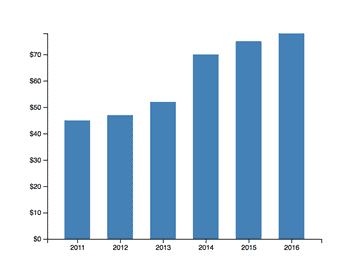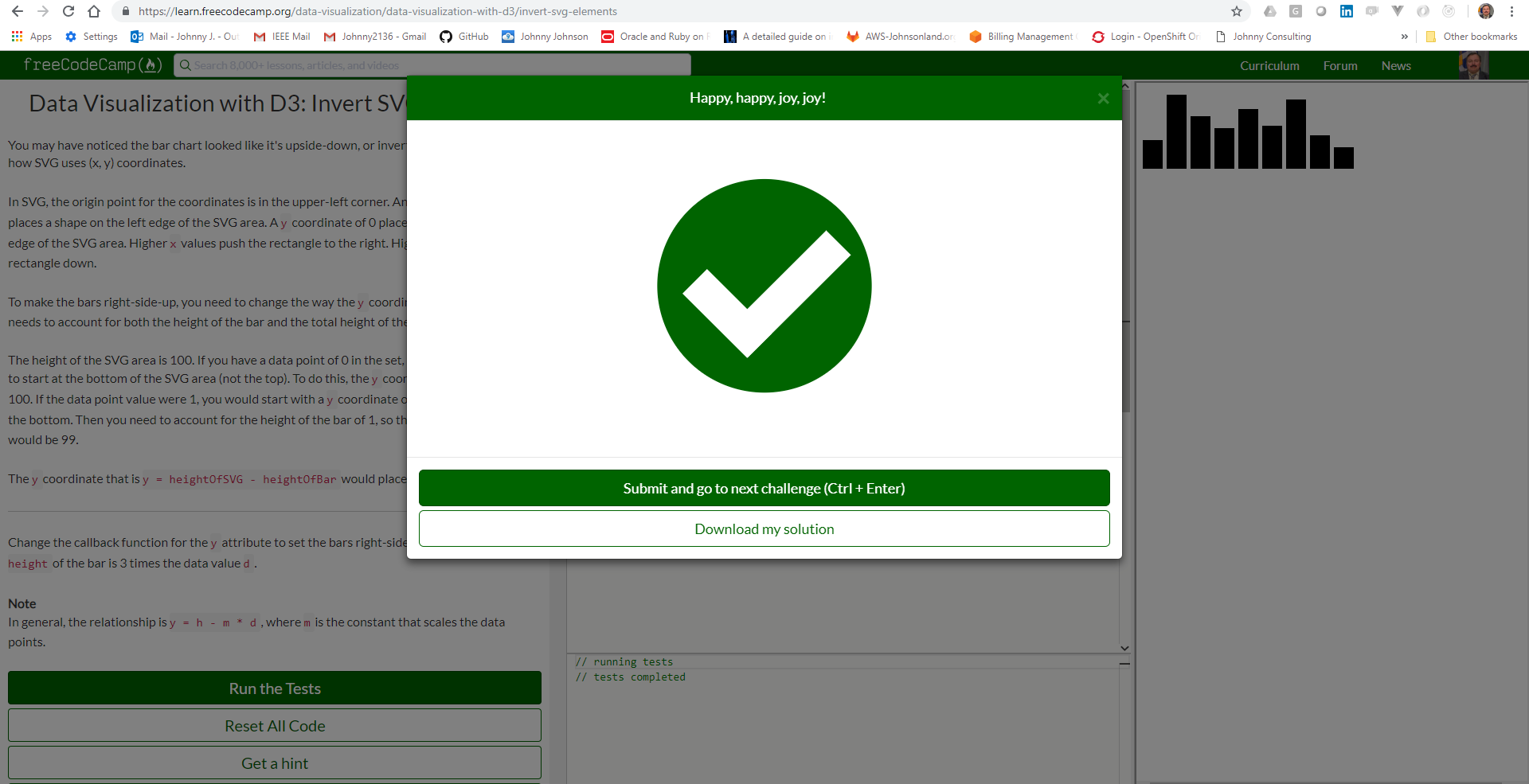44 data visualization with d3 add labels to d3 elements
Adding the Y-Axis Label - D3 Tips and Tricks: Interactive Data ... What is D3.js? Starting with a Simple Graph A Simple Graph HTML Cascading Style Sheets (CSS) D3 JavaScript Setting Up the Margins and the Graph Area Getting the Data Formatting the Date and Time Setting Scales, Domains, and Ranges Adding Data to the Line Function Adding the SVG Element Actually Drawing Something! Challenge: Change X-Axis Display Getting Started with Data Visualization Using JavaScript and the D3 ... Introduction. D3.js, or D3, is a JavaScript library.Its name stands for Data-Driven Documents (3 "D"s), and it's known as an interactive and dynamic data visualization library for the web.. First released in February 2011, D3's version 4 was released in June 2016. At the time of writing, the latest stable release is version 4.4, and it is continuously being updated.
Customize your graph visualization with D3 & KeyLines Adding link labels with D3 With D3 you need to append a new text element to links, but you can't just append a g element to group line and text, the way we did with nodes. Link lines positioning require two points coordinates (x1,y1 and x2,y2) while groups have no coordinates at all and their positioning needs a translation in space.

Data visualization with d3 add labels to d3 elements
Creating Data Visualizations with D3 and ReactJS - DEV Community Let's go through each part of that D3 line on line 17 and breakdown what it does: d3.select ("#pgraphs") selects the div with the id "pgraphs" .selectAll ('p') tells d3 that we want to look at the p tags within that div. Since there are currently no p tags, we will later need to create them. .data (dataSet) binds that dataSet array to these p tags Add Labels to D3 Elements - The freeCodeCamp Forum You typed "dataset". You might have meant dataset (without the quotes). In .attr ("y", you used an i variable but you forgot to include it in the parameter list. In .text (), d is just a plain variable that's not declared anywhere. If you intend to display the current data point, use d => d. The above won't be enough to pass the exercise. Add Labels to D3 Elements - freeCodeCamp Add Labels to D3 Elements D3 lets you label a graph element, such as a bar, using the SVG text element. Like the rect element, a text element needs to have x and y attributes, to place it on the SVG canvas. It also needs to access the data to display those values. D3 gives you a high level of control over how you label your bars.
Data visualization with d3 add labels to d3 elements. Using D3.js with React: A complete guide - LogRocket Blog First, we defined a variable, data, which contains the data we want to visualize. Next, we defined an SVG using D3.js methods. We're using SVG because it's scalable — that is, no matter how large the screen is or how much you zoom in to view the data, it will never appear pixelated. d3.select() is used to select an HTML element from the document. FCC-Projects/DataVisualizationWithD3.md at master - GitHub The first step is to make D3 aware of the data. The data () method is used on a selection of DOM elements to attach the data to those elements. The data set is passed as an argument to the method. A common workflow pattern is to create a new element in the document for each piece of data in the set. D3 has the enter () method for this purpose. freecodecamp-solutions/17-add-labels-to-d3-elements.html at ... - GitHub freecodecamp-solutions/Data Visualization Certification/Data Visualization with D3/17-add-labels-to-d3-elements.html Go to file yadavanuj1996 Start data visualization certification. Latest commit e5034e7 on Aug 1, 2019 History 1 contributor 35 lines (29 sloc) 827 Bytes Raw Blame D3 - A Beginner's Guide to Using D3 - MERIT This code will specify where your d3 visualization will be placed in the HTML page 3) Declare Variables - Here we first specify the data we will be using in our line graph as the arrays data1 and data2. The height and width of our graph will be determined by w and h.
Data Visualization with D3 · GitHub - Gist Data Visualization with D3 This file contains bidirectional Unicode text that may be interpreted or compiled differently than what appears below. To review, open the file in an editor that reveals hidden Unicode characters. Learn more about bidirectional Unicode characters Show hidden characters Data Visualization with D3: Add a Hover Effect to a D3 Element Data Visualization with D3: Add a Hover Effect to a D3 Element. It's possible to add effects that highlight a bar when the user hovers over it with the mouse. So far, the styling for the rectangles is applied with the built-in D3 and SVG methods, but you can use CSS as well. javascript - Add labels to D3 Chord diagram - Stack Overflow You need to look at the ( selection.on ()) event handler in the d3.js wiki on Github. That shows you how to add events to elements including mouseover and mouseout. If you look at that example you linked to, you can see an instance of it already: Data visualization with D3.js for beginners - Medium A web based visualization library that features a plethora of APIs to handle the heavy lifting of creating advanced, dynamic and beautiful visualization content on the web. D3.js is a JavaScript library for manipulating documents based on data. D3.js helps you bring data to life using HTML, SVG, and CSS.
Data Visualization with D3.js and Angular JS - Tivix Angular JS and D3.js can both maneuver SVG graphics, HTML elements and static data independently and do so perfectly well. You will begin to see the benefits of each library for creating visualizations with data. In general, D3.js is the more straightforward to use if you're new, as it is similar to jQuery and the syntax is direct. D3 for Data Scientists, Part II: How to translate data into graphics We first define a table, called date_labels, with the year labels we want to display. The next block is where the D3 magic happens! Again, we start by appending to svg. Next, selectAll ('.date_label_top') creates a D3 selection containing all elements in the DOM (Document Object Model) with class 'date_label_top'. Use data attached to a visual element to affect its appearance | D3.js ... Adding a link to the D3 library; Adding antag and sizing it with D3; Creating some fake data for our app; Adding SVG circles and styling them; Creating a linear scale; Attaching data to visual elements; Use data attached to a visual element to affect its appearance; Creating a time scale; Parsing and formatting times; Setting dynamic domains Understanding the difference between the d3 data and ... - Into the Void One of the neatest and simultaneously confusing aspects of D3 is its data binding methods selection.data and selection.datum that bind data to elements in the DOM. These methods while seemingly simple, enable effortless generation of very complex data visualizations by virtue of keeping visualization elements in the DOM closely coupled to the data being visualized.
An introduction to accessible data visualizations with D3.js Instead of first looping through our data to draw the values on the x-axis and later on looping through the data a second time to draw the labels above the graphs, we will only loop through our data once and append a group to it. const ticks = chart.selectAll (".tick") .data (data) .enter ().append ("g") .attr ("class", "tick");
Introduction to Data Visualization with D3 - Chapter 1 - SitePoint This book follows the journey of a beginner learning the most popular tool, D3.js, a JavaScript library for visualizing data. D3 enables you to bring data to life—getting data from various sources,...
Creating Data Visualizations with D3 and ReactJS - Medium Let's go through each part of that D3 line on line 17 and breakdown what it does: d3.select ("#pgraphs") selects the div with the id "pgraphs" .selectAll ('p') tells d3 that we want to look at the...
How to use Canvas with D3 for data visualization - Pluralsight D3 (or D3.js) is short for three important D-words: Data-Driven Documents. It's a common - and excellent - choice for building interactive visualizations for the web. D3 excels when data must be bound to interactive elements, and when you want hassle-free transitions.
Data Visualization with D3 - SpringerLink D3 stands for Data-Driven Documents and is a JavaScript library used to create interactive data visualizations. The seed of the idea that would become D3 started in 2009 as Protovis, created by Mike Bostock, Vadim Ogievetsky, and Jeff Heer while they were with the Stanford Visualization Group.
How to Make Stunning Data Visualizations With D3.js - Medium D3.js is a JavaScript library that we can use to create data visualizations with the use of HTML, CSS, and SVG. The name itself stands for Data-Driven Documents. It's an extremely powerful framework for creating all kinds of visualizations with smooth animations and interactivity.
Data visualization in Angular using D3.js - LogRocket Blog npm install d3 && npm install @types/d3 --save-dev. Next, create three new components using the Angular CLI. In the following steps, you'll use D3 to generate data visualizations within each one. Don't miss a moment with The Replay, a curated newsletter from LogRocket. Use React's useEffect.





Post a Comment for "44 data visualization with d3 add labels to d3 elements"